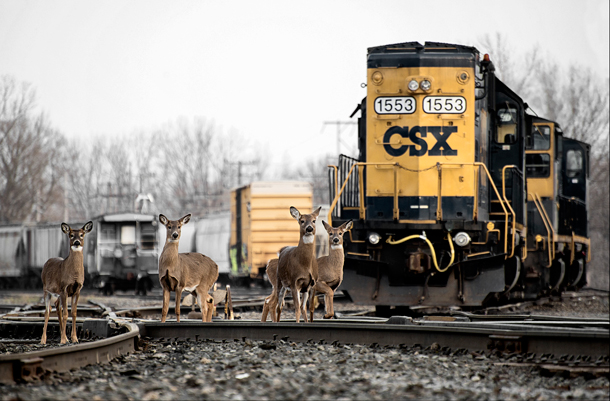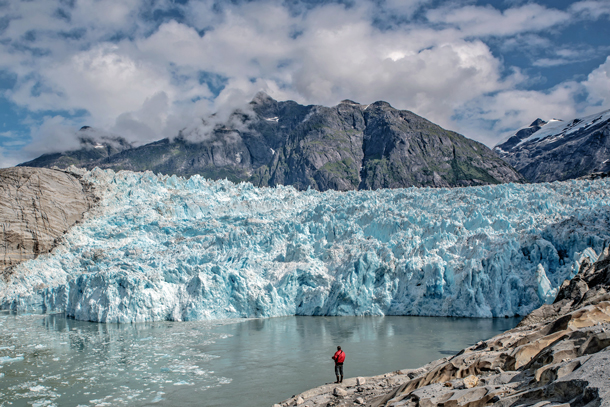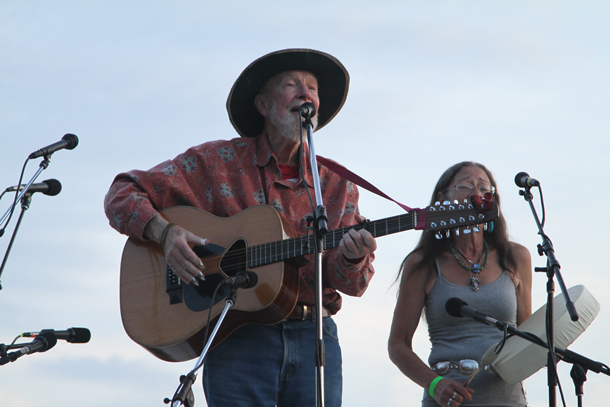Beyond The Headlines
Air Date: Week of May 10, 2019

Untold numbers of animals, both big and small, from elephants to frogs, are killed on railroad tracks each year. One proposed solution is to play predator sounds near tracks. (Photo: Timothy Vogel, Flickr, CC BY-NC 2.0)
Looking beyond the headlines, Peter Dykstra talks with Host Steve Curwood about an unexpected wildlife killer of creatures big and small: trains. They then discuss rising tourism to the world’s melting glaciers, as well as the fiftieth anniversary of the founding of Hudson River Sloop Clearwater, a nonprofit floating lab and classroom founded by Pete Seeger to preserve the Hudson River through education, advocacy, and—of course—musical celebration.
Transcript
CURWOOD: Let's take a peek behind the headlines now with Peter Dykstra. Peter's an editor with Environmental Health News, that's EHN.org and dailyclimate.org. On the line now from Atlanta, Georgia; hi there, Peter. How are you doing?
DYKSTRA: Well, I've been working through a little cold, but bear with me. We've got some interesting things to talk about. Starting with railway collisions with wildlife, from elephants to grizzly bears to even small frogs that are too fat to jump over the rails, we're beginning to understand how big the problem is. One little fact in a field that doesn't really have many numbers attached to it yet: over the last 30 years on Indian railways alone, 220 elephants have been struck and killed by trains.
CURWOOD: So that means almost an elephant every month or two gets killed by a train there.
DYKSTRA: Right. Those have to be pretty messy collisions, in addition to impacting a population that doesn't need any more negatives.
CURWOOD: So of course, a railway creates an edge habitat, right? I mean, whenever the rail line went up, there's this little area that's right next to it that goes, you know, way back in the day and animals like.
DYKSTRA: A lot of animals love it, including deer, the main source of car collisions in this country and in a lot of other places. That edge habitat, where sunny areas meet the forest, is a great place for a lot of predators to find food. It's also a great place for plant-eaters to find food, and every railway is edge habitat.
CURWOOD: So what's to be done? I mean, we just heard about the precipitous decline in wildlife thanks to development and climate disruption. There must be something that could be done.
DYKSTRA: They’re trying a few things in a few places around the world. There are recordings of predator noises being played near railroad tracks, hopefully to scare away animals that might fear being eaten more than they fear being hit by a train. Airports in a lot of places use sound cannons, little blasts to scare away Canadian geese and other animals that could tend to get stuck in jet engines. We don't know how big the problem is. We're beginning to get a grip on it. And solutions need to come soon, because it's potentially a major impact on wildlife.

As glaciers melt, tourists flock to see the icefields before they’re gone. Pictured here is Alaska’s LeConte Glacier expanse, which—like so many glaciers around the world—is disappearing. (Photo: Carey Case, US Forest Service, Flickr, CC BY 2.0)
CURWOOD: Hey, what else do you have for us today Peter?
DYKSTRA: Well, there's an unusual increase in tourism: people flocking to see melting glaciers before the glaciers are entirely melted away. There's a big boom in Montana in Glacier National Park where many of the glaciers are already gone and the rest are going quickly. Places like Kilimanjaro; the Alps; folks are going out to see something that may not be there for long. I kind of did the same thing with my kids back in 2005. On a trip to New Orleans, I took them out to Grand Isle, the one beach town left in southern Louisiana, because I wanted to have them see a place that would be doomed by hurricanes. The irony is that Grand Isle is still there, and a lot of New Orleans disappeared six months later. It's kind of a reverse bucket list. Instead of seeing a place before you die, you see a place before it dies.
CURWOOD: Indeed, if we keep going the way we are, there are going to be a lot of places like that.
DYKSTRA: Right, there's a double-edged sword with the glacier tourism, though. There's more business, there's more climate change awareness when people go out to see vanishing glaciers. But at the same time, if you're increasing plane travel, or car or bus travel, just to see the glaciers, you're actually contributing to their death.
CURWOOD: If you're putting more carbon into the atmosphere, certainly. Alright, it's time for us to take a look back in the annals of history and -- tell me what you see.

Musician and activist Pete Seeger (with guitar) founded Hudson River Sloop Clearwater in 1969. The nonprofit is named after a 106-foot long replica of a historic sloop (a kind of boat that sailed the Hudson in the eighteenth and nineteenth centuries) that sailed the Hudson in the eighteenth and nineteenth centuries. Today, the Clearwater organization uses education, advocacy, and music to promote conservation and sustainability. (Photo: Pete Seeger, “Turn, Turn, Turn,” Jim, the Photographer, Flickr, CC BY 2.0)
DYKSTRA: A 50th anniversary of note: Pete Seeger and some other volunteers launched the Hudson River Sloop Clearwater on May 17th, 1969. And for 50 years, the Clearwater has sailed up and down the Hudson River, other waterways and ports along the Northeastern US. It's a floating lab and a floating classroom on saving waterways. And it's been a symbol of the great comeback of the Hudson River for the past half century.
CURWOOD: But all is not well with the Hudson River yet though, is it?
DYKSTRA: No the PCB dumping that was the Hudson's biggest problem still isn’t resolved and believe it or not, the EPA just gave a pass to General Electric, PCB dumper back to the 1940s and earlier, to not continue with their cleanup. It's a setback. It's proof that not only does the Clearwater have more work to do, but other organizations it helped to spawn, like the Riverkeeper. The first Riverkeeper was started by a Clearwater crew member named John Cronin and also Bobby Kennedy, Jr. There are now Riverkeeper and Baykeeper chapters all over America and all over the world.
CURWOOD: This sounds largely like a success story, Peter. Thank you for reminding us of that. Peter's an editor with Environmental Health News, that’s EHN.org and dailyclimate.org. And we'll talk again real soon.
DYKSTRA: All right, Steve, thanks a lot. We'll talk to you soon.
CURWOOD: And there's more on these stories on our website, loe.org.
[MUSIC: Pete Seeger, “Sailing Down My Golden River”]
Links
Living on Earth wants to hear from you!
Living on Earth
62 Calef Highway, Suite 212
Lee, NH 03861
Telephone: 617-287-4121
E-mail: comments@loe.org
Newsletter [Click here]
Donate to Living on Earth!
Living on Earth is an independent media program and relies entirely on contributions from listeners and institutions supporting public service. Please donate now to preserve an independent environmental voice.
NewsletterLiving on Earth offers a weekly delivery of the show's rundown to your mailbox. Sign up for our newsletter today!
 Sailors For The Sea: Be the change you want to sea.
Sailors For The Sea: Be the change you want to sea.
 The Grantham Foundation for the Protection of the Environment: Committed to protecting and improving the health of the global environment.
The Grantham Foundation for the Protection of the Environment: Committed to protecting and improving the health of the global environment.
 Contribute to Living on Earth and receive, as our gift to you, an archival print of one of Mark Seth Lender's extraordinary wildlife photographs. Follow the link to see Mark's current collection of photographs.
Contribute to Living on Earth and receive, as our gift to you, an archival print of one of Mark Seth Lender's extraordinary wildlife photographs. Follow the link to see Mark's current collection of photographs.
 Buy a signed copy of Mark Seth Lender's book Smeagull the Seagull & support Living on Earth
Buy a signed copy of Mark Seth Lender's book Smeagull the Seagull & support Living on Earth

